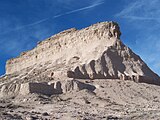|
Pawnee Buttes
The Pawnee Buttes are two prominent buttes in northeastern Colorado. The west butte is located within the Pawnee National Grassland, while the east butte is on private land in Weld County. Rising approximately 300 feet (91 m) above the surrounding plains, the buttes are erosional remnants left standing in isolation as the surrounding High Plains surface has gradually worn away. The lower portions of the buttes are composed of relatively soft, clay-rich sedimentary rock called the Brule formation. The Brule formation is protected by an overlying layer of sandstone and conglomerate sediments called the Arikaree formation, which are more resistant to weathering.[1] GeologyThe buttes are in the northeastern edge of the Colorado Piedmont. To the north, the piedmont is bordered by the Chalk Bluffs, an escarpment on the edge of the High Plains. As the rains and snows slowly erode the bluffs, the piedmont grows towards the north. Stream capture expands the piedmont rapidly towards the upslope or westward. The Buttes themselves are remnants of the High Plains surrounded by the piedmont. Another remnant of the high plains is to the west where the Chalk Bluffs form the eastern edge.[2] The Buttes are a consolidation of several geological ages. The main mass of the butte is the lower half to two-thirds. It is a buff-colored layer from the Brule member of the White River Formation. It is from the Oligocene Epoch (25-40 mya).[2] Below this level and visible only further east than the buttes is the Chadron member of the White River Formation.[2] Above the Brule layer is the Pawnee Creek Formation from the Upper Miocene (20 mya). The cap of the buttes is the Arikaree Formation, also of the Miocene age.[2] Research in the 1970s suggest that the upper level of the cap rock is of the Ogallala Formation from the Pliocene. The Pliocene layers exist further to the north in the High Plains region.[2] The cap rock is a harder mixture of sandstone and conglomerate, while the Brule layers are a softer clay. The surrounding area is considered a badlands as North Pawnee Creek cuts numerous channels into the Brule Formation soils.[2] Vegetative zones
Pawnee Buttes TrailThe Pawnee Buttes Trail is noted for its scenery and birdwatching potential. The Overlook, the Lipps Bluff trail, and the area within 200 yards of the cliffs are closed to hikers from March 1 to June 30, to protect nesting falcons, eagles, and hawks. Hikers are encouraged to keep away from these areas during that time to minimize disturbance to the nesting birds. Appearance in James A. Michener's, CentennialThe Pawnee Buttes feature proximately in James A. Michener's 1974 novel, Centennial. Dubbed the 'Rattlesnake Buttes' they form the backdrop for the nearby fictional town of which the novel is centred around.[4] Subsequently the Pawnee Buttes are also utilised as a filming location for various scenes in the 1978 Centennial miniseries which is an adaption of James A. Michener's novel.[5] See alsoWikimedia Commons has media related to Pawnee Buttes.
References
External links
|
||||||||||||||||


![Pawnee Buttes (1900)[3]](http://upload.wikimedia.org/wikipedia/commons/thumb/b/ba/PawneeButtes_1900_USGS.jpg/191px-PawneeButtes_1900_USGS.jpg)

